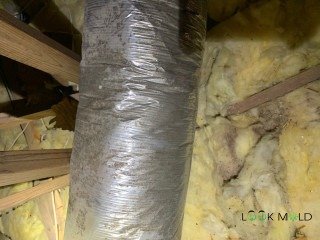Mold on the Outside of Ductwork
Expert insight by: Brad Fishbein, Licensed Mold Assessor
Updated February 2, 2023
It’s a well-known fact that mold in air conditioning ducts can cause problems with the air quality within the home, but what about mold on the outside of ductwork?
Can this cause a problem?
In this article, we are going to explore the reasons why mold grows on the outside insulation of the ductwork, if it’s a problem and how to get rid of it.
What Causes Mold On The Exterior Of The Air Ducts in the Attic?
HVAC ductwork runs typically throughout the attic space above the home unless with sometimes, in older homes, the ductwork runs beneath the house. In either case, the ductwork runs through a hot and humid place during the summer months.
When cold air is running through the ductwork in a hot and humid space such as the attic or crawl space, condensation will build-up. Mold spores will then attach itself to the wet building material and grow on the surface of the outside insulation on HVAC Ductwork.

Is Mold On The Outside of Ductwork Dangerous?
The mold that accumulates on the outside insulation of ductwork will typically not affect the indoor air quality within the living space of the home. The mold is on the outside of the ductwork and not within the HVAC system itself.
Does this mean that you should not be concerned?
No, there is still mold in your attic. Excessive build-up of mold should be avoided if possible. However, it’s typically harmless. The type of mold present will likely be called Cladosporium.
Cladosporium mold spores are generally found both indoors and outdoors. Of course, you don’t want to have this species of mold in your home in large amounts; however, if contained to your attic space is unlikely to cause harm to a human’s health.
How To Clean Mold On The Outside Of The HVAC Ductwork
Cleaning up mold on the outside of the air ducts is relatively easy. If you have any severe allergies to mold, this is better left to be done by either a mold professional or an HVAC professional.
A minimum N-95 mask should also be worn at all times. Other Personal Protective Equipment such as gloves should also be put on. How to clean outside insulation of ductwork
- Step 1- Get a rag and a Small Bucket and Fill It With an EPA Registered Disinfectant or Anti-microbial solution.
- Step 2- Get the rag damp (do not fully soak) and wipe the outside insulation gently.

Mold On Ductwork In A Sealed Attic
Newer construction homes are starting to seal up their attics with foam insulation and closing the soffit vents. This is making homes more energy-efficient and can promote better overall air quality.
The downside of sealing up the attic is when it’s not done properly. When sealing up the attic, the humidity should really only be a little higher in the attic space compared to the living space (5-10% higher).
If an attic is not completely sealed and hot air is getting into the attic, it can create many problems. One of those problems is the build-up of mold on the outside of the HVAC ductwork. While this may be one of the most straightforward problems you have to deal with, it is nevertheless a problem.
Bottom line: If you see mold on the outside of ductwork in a sealed attic, it could indicate a more significant issue. Conclusion
Mold on the outside of the ductwork is not a significant issue, and it can generally be resolved without professional mold remediation. Mold inside your air conditioning ducts is a much more critical issue to resolve than the outside.
Cleaning up your attic is a DIY job, or you can hire a licensed HVAC contractor.
Explore Related Topics:

Meet the author: Brad Fishbein is an ACAC council-certified Microbial Investigator. In the fall of 2012, he became a Licensed Mold Assessor in the State of Florida through the Department of Business & Professional Regulation. Brad has helped homeowners with over 5,000 successfully completed Mold Inspections since 2009.

